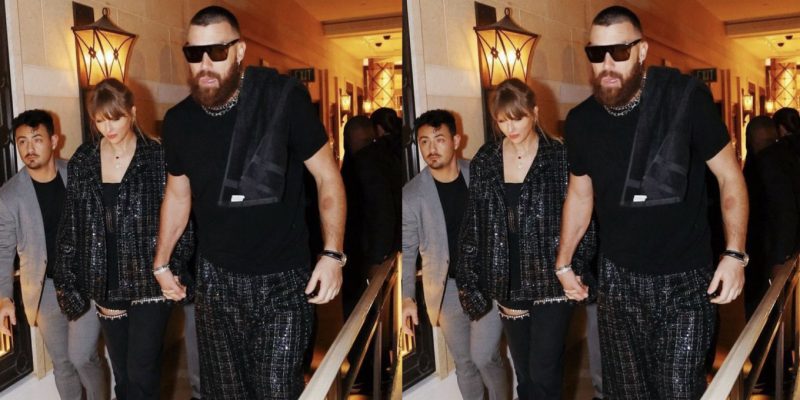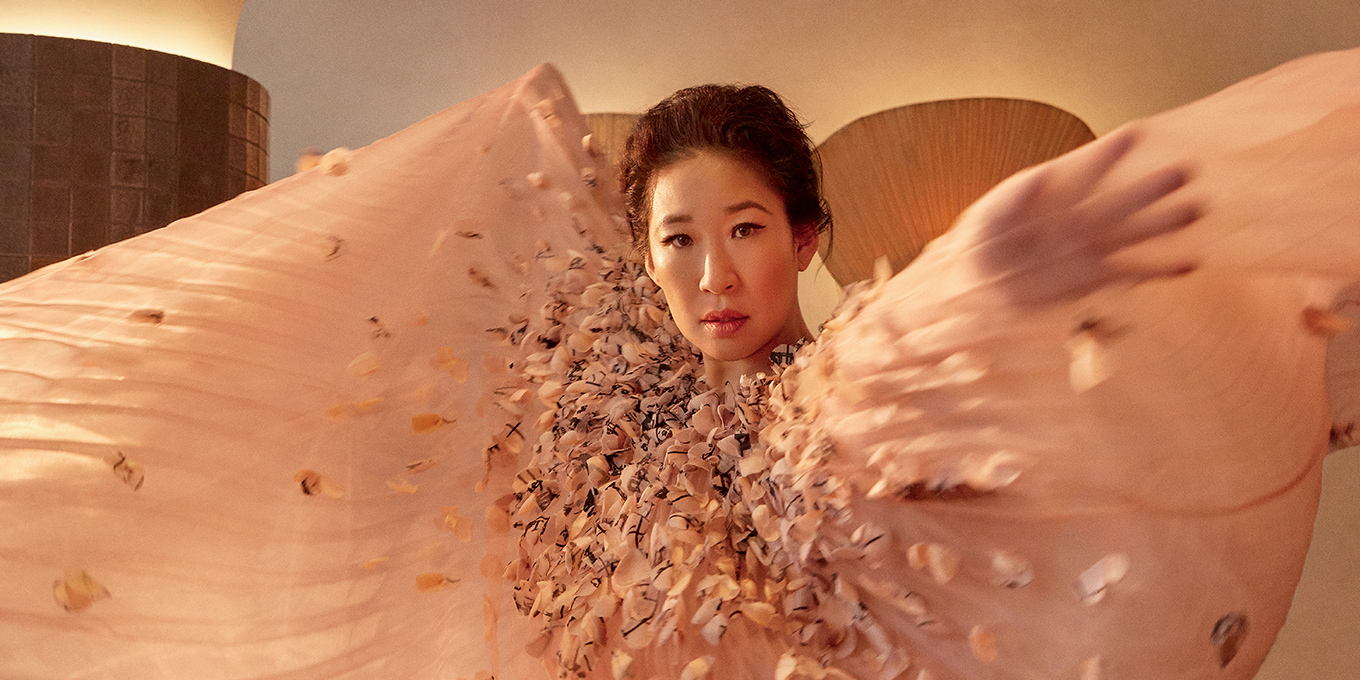
Greg Swales
Sandra Oh Is in a League of Her Own
What makes a woman of character? Just ask Sandra Oh.
by : Vanessa Craft- May 12th, 2020
Sandra Oh is leaning out of an alcove in a Santa Monica restaurant, a baker-boy hat pulled over her signature multi-tiered hair, asking a waiter for assistance: Could she please have some hot sauce? It’s a simple request, but the waiter, grinning, bounces over with a small bowl of some, obviously relishing his role.
I understand his enthusiasm. There is an electricity to being in Sandra Oh’s universe, even if you’re just handing her hot sauce or griping about L.A. traffic, as we just were. The 48-year-old Korean-Canadian, clad in wide-legged jeans, a Gucci belt and a T-shirt from the play Cambodian Rock Band, seems able to effortlessly connect with people. For example, there’s the group of middle-aged women who barely contain themselves when Oh steps out of the hotel elevator; the teens who are discovering Grey’s Anatomy for the first time on Netflix and making #CristinaYang TikToks (an infinite scroll of adoring content about how she will always be “their person”) that have amassed 13.9 million views; our fashion team from Montreal, who are enamoured when Oh switches to French to speak with them the whole time we’re on-set; and certainly her industry peers, who have sent multiple SAG Awards and historic Golden Globe wins her way.
Oh’s charisma crackles in Killing Eve, which debuted its third season in April. The critically acclaimed, multiple-award-winning thriller documents the obsessive cat-and-mouse relationship that develops between a professional killer, Villanelle (British actress Jodie Comer), and her pursuer, rogue MI6 agent Eve Polastri (Oh). Though it features grisly murders committed with poison-dipped hairpins and deadly perfume mists, Killing Eve is fundamentally about a pair of women consumed by their ambition and, ultimately, the undeniable sparks that fly when two people operating at the top of their game connect. These complicated characters aren’t easy to like, yet they are irresistibly compelling—and Oh’s is exactly the type she has always excelled at.
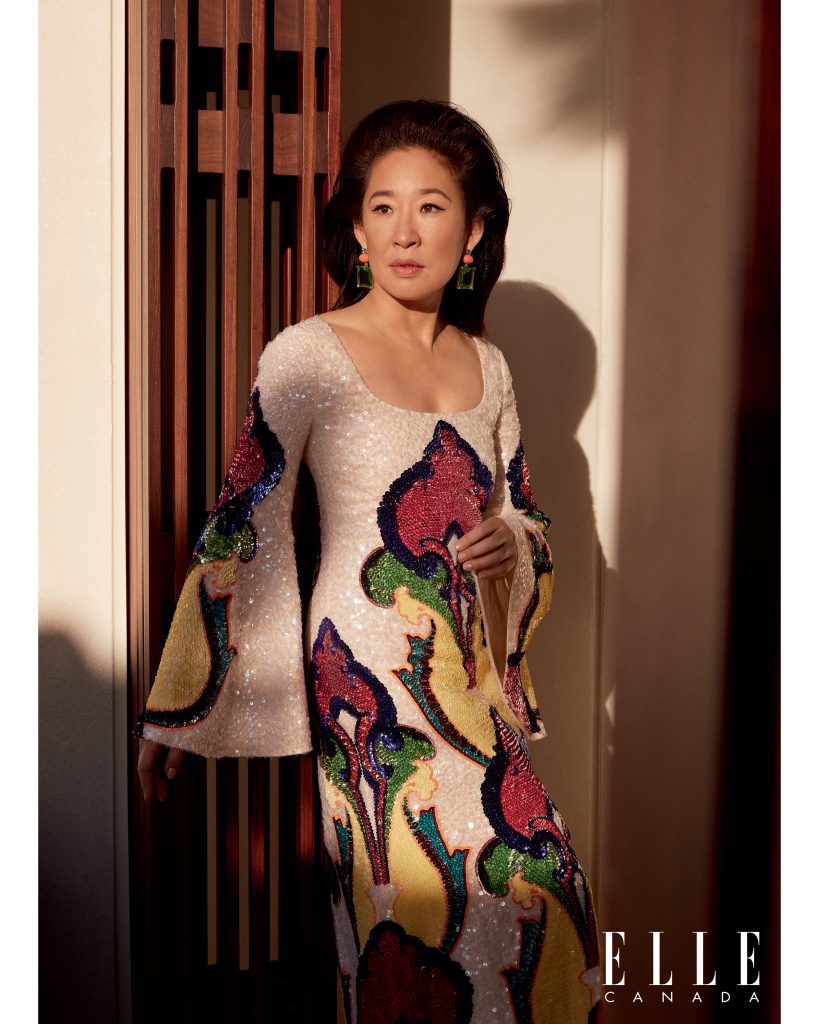 Greg Swales
Greg Swales Sequin-embroidered linen dress (Gucci) and gold-plated-metal earrings with peridots, blue crystals and faux-coral cabochons (Kenneth Jay Lane x Brandon Maxwell)
In fact, it was playing another thorny and complex woman, Dr. Cristina Yang on the hugely successful medical drama Grey’s Anatomy, that made Oh a household name. “I decided that I’m only going to play characters that are essential to the plot, that conduct the narrative and therefore can’t be cut out,” she explains. Of course, the crucial step, she adds, “is that you have to get to a place [in your career] where you can say no.” Oh’s commitment to this standard and what she brings to her performance is why Shonda Rhimes, the powerful creator and executive producer of Grey’s, openly mourned when Oh left the show in 2014 after 10 seasons. “I grieved [no longer] writing for Sandra more than anything because I [wouldn’t] get to see what she would do with it,” she explains over the phone. “I think she chooses characters and then inserts herself into them. There are plenty of actors who want to be nice or who want to be seen as romantic or who want to be seen as a hero, but Sandra’s not interested in that. She’s interested in playing the stuff of life.”
Oh has always had clarity about what she wants to do. Though she studied ballet while growing up in Ottawa, her desire to be an actress became all-consuming in high school. She joined improv groups and put on shows for her South Korean parents with her two siblings. When she turned down a scholarship offered by Carleton University and instead attended Montreal’s National Theatre School, where she had to pay her own tuition, her businessman father and biochemist mother initially found it hard to accept.
“There are plenty of actors who want to be nice or who want to be seen as romantic or who want to be seen as a hero, but Sandra’s not interested in that.”
When I ask how she “got the balls” to follow her heart, she quickly corrects me, saying she prefers to say “eggs,” before adding with a laugh and a shrug, “I’ve always had a large set of eggs.” But while accepting a Governor General’s Performing Arts Award last spring in Ottawa, Oh acknowledged that she had struggled to win her parents’ approval. “On that NTS stage, I unabashedly performed a skit about me confronting my parents to let me attend the National Theatre School,” she said in her speech, to laughter from the spectators. “I worked out all that family drama in front of an audience—while my parents sat in that audience. Thank you, Mom and Dad!”
How do all the accolades and the enthusiasm around her career feel? Oh says, “It’s good to hear that people are excited about what I’m doing— especially in the context of having a career that has spanned [she theatrically lowers her voice to a whisper] decades.” Oh may deadpan about how long she’s been in the business, but she wears her drive, determination and confidence so comfortably, without apology and without asking for praise. “Sandra is intense when she is playing a role, and I mean that in the best way,” says Rhimes, explaining that Oh would come charging into her office every week, script filled with notes, asking countless questions about word choice and character motivation. “It drove me crazy and made me so happy at the same time,” says Rhimes. “Sandra wanted to get it as right as she possibly could. She could elevate anything you wrote—she dives in and cares deeply. You cannot have a superficial conversation with Sandra.”
The depth of Oh’s work shows up in every episode of Killing Eve. Onscreen, the chemistry between Oh and Comer is palpable. “I have a very deep connection to her,” says Oh. “When we come together, there’s a deep amount of trust. We’re pushing each other. We trust that space of alchemy between us. She’s really confident in her instincts, as I am in mine.”
 Greg Swales
Greg Swales Satin dress and leather belt (Christopher Kane), PVC heels (Versace) and gold-and silver-tone-metal earrings (Bottega Veneta)
On the show, Oh and Comer’s characters may be equals in their ambition and obsessions, but there is a clear winner when it comes to their signature styles. Comer’s Villanelle struts about in Chloé suits and J.W. Anderson jackets, while Oh’s Eve pulls on sensible turtlenecks and windbreakers. “It kills me!” says Oh when I mention the discrepancy. “I go into wardrobe and see that bitch’s clothing, and I’m just like, ‘Can I get something above Uniqlo? No?’”
She’s laughing, but she’s serious about the “huge” importance of fashion on the show. “What are you saying about a character’s mindset when she dresses over-the-top?” she asks. Eve’s wardrobe subtly but crucially showcases her metamorphosis and how she is influenced by Villanelle’s sophisticated style. “Eve is always in neutral, basic tones, right?” says Oh. “She’s always earthy, in a lot of turtlenecks. The beauty is in how she changes. She changes in fabric. She changes in line, in shape.” As she gets closer to Villanelle, for example, Eve moves from wearing a men’s parka to a women’s parka; her pieces go from being oversized to more fitted. “But it’s all still in her colour palette, so you still keep the character.”
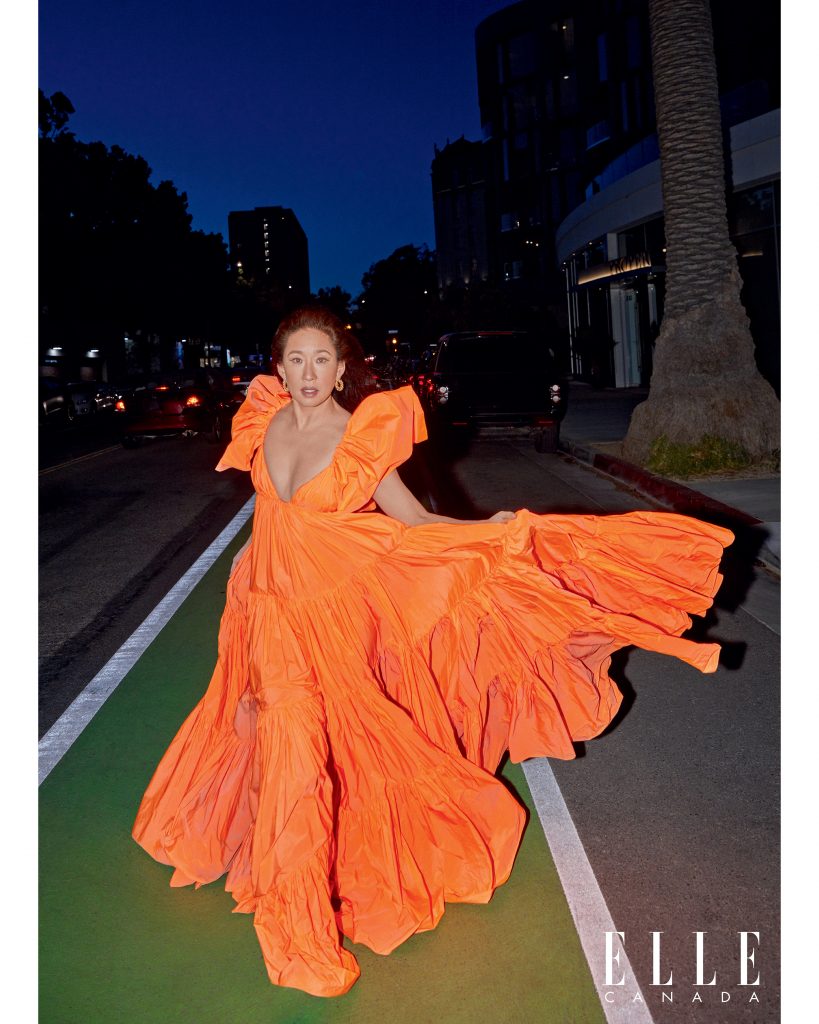 Greg Swales
Greg Swales Taffeta dress (Valentino) and gold-plated-metal earrings (Laura Lombardi)
At the time of our meeting, in early March, Oh hadn’t posted anything to her Instagram account since October 2019. Her lack of social-media proficiency (even just talking about how to use TikTok makes her recoil and slide down her chair with mock fear) means that big news, like her performance at Carnegie Hall with Philip Glass or the announcement of her new show, The Chair, which she stars in and is an executive producer for, didn’t show up on her feed for any of her 3.4 million Instagram followers to see. “I know I’m supposed to do something with the pictures!” she says. “But then I’ve left it to the next day, and I think it’s too late…and then a week goes by and it’s even later, and who’s going to care now? I keep missing the window.” When reminded of a little something called a #tbt post or a #latergram or the ability to post something quickly as an Insta story, she shakes her head and says, “I am the classic ‘aunt’ who can’t make things work” and then does an imitation: “Honeeeey? Can you make it work? I don’t know what this is.”
“I’m in a place in my career now where I am specifically interested in roles that explore a character’s race.”
Prior to her television takeover, Oh flexed her acting muscle in films like Last Night, Sideways and The Diary of Evelyn Lau and more recently got to show her delightful sense of humour on Saturday Night Live and at the 2019 Golden Globes, when she hosted alongside Andy Samberg. She was the first Asian woman to host the show. (“It really, really terrified me, but that was the reason I did it.”)
Lately, much has been made in the representation conversation about minority actors being cast in roles that are essentially “colour-blind,” effectively removing the stereotype that only someone who looks a certain way can play a lead role and opening up opportunities for PoC to play roles outside the typically typecast ones. “But I’m in a place in my career now where I am specifically interested in roles that explore a character’s race,” says Oh. “Because I can—and because I want our conversations to eventually move to a place that recognizes that it’s important. Let’s say it’s a show about a fashion magazine and the editor’s Black. You can’t just write this character without having the background of who she is. But that has been the primary storytelling for as long as we’ve been around.” That one-dimensional approach makes little sense, because we all know how often a person’s race or culture influences their choices or way of navigating the world. “Asian-Americans, particularly from my generation, almost recoil if we hear an accent [onscreen] because of how laden in racism and misunderstanding [it is] and [how it’s a result of] not being in charge of the story,” she says.
 Greg Swales
Greg Swales Silk shirt and leather skirt (Louis Vuitton) and gold-tone- metal earrings (Balenciaga)
Oh pauses for thought and reflects on a shift she is excited to see happening: younger actors who “carry” their accent. “If you are Korean-American and from Los Angeles, you have an accent, but they aren’t trying to flatten their accent, like I have,” she says. “They are just carrying that into the character of, say, a doctor. That’s how we get the shift. We don’t want to just have a person of colour acting the way a white person would act. Because they’re not!”
Oh believes that she is part of a generation of actors, writers and directors who have the opportunity—and the burden, admittedly—to be constantly teaching in that regard. “I’m happy to take that on,” she says.
Rhimes backs this up. “It was a very unspoken thing for us [on Grey’s]: You don’t have to have that conversation with another woman of colour about being a woman of colour and being the ‘first’ anything because you both know what that feels like,” she says. “So we were very cognizant of the responsibility we had, and there were many moments when Sandra was really brave and instructive.”
As we finish our breakfast, Oh pushes her empty coffee cup away and reflects on her drive for her work. “As you mature, you look for meaning, you look for connection to the world,” she says. “You’re working for purposefulness—and if you can get that from your work? What a blessing.”
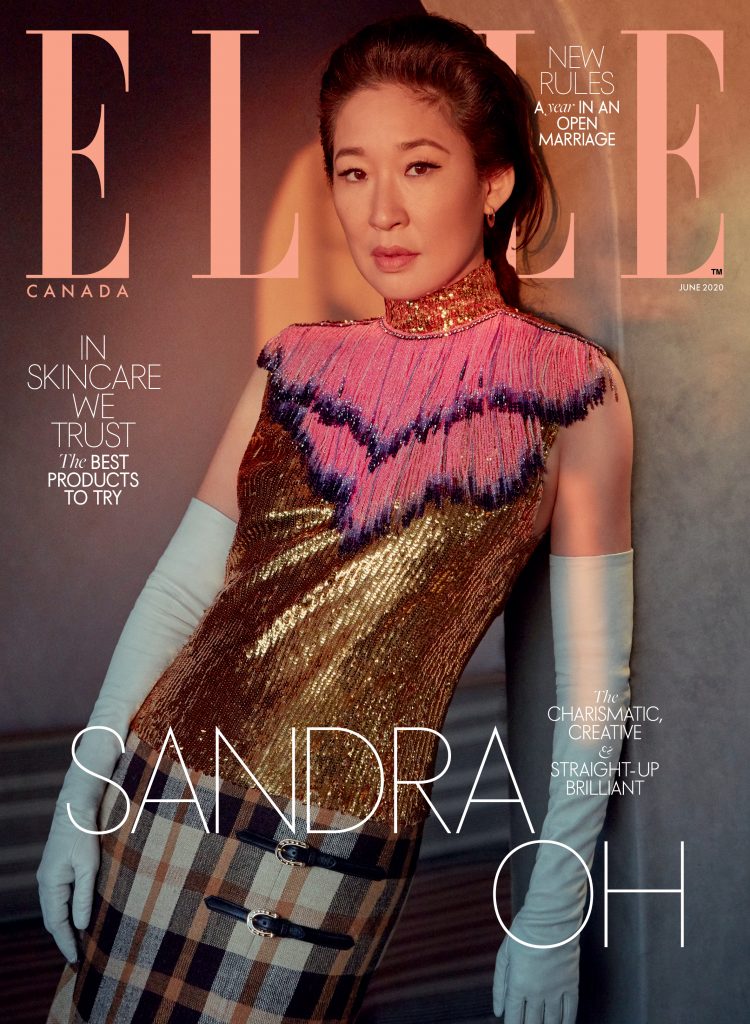
Writer, Vanessa Craft; photographer, Greg Swales; creative director & stylist, Annie Horth; stylist, Patrick Vimbor; art director, Jed Tallo; makeup, Kara Yoshimoto Bua (SWA); hair, Jenny Cho (SWA); nails, Christina Aviles Aude (Star Touch); editorial producer, Estelle Gervais; photographer’s assistants, Yolanda Leaney and Amanda Yanez; styling assistant, McCall O’Brien; makeup assistant, Pircilla Pae. Shot on location, prior to COVID-19 distancing measures, at Santa Monica Proper Hotel. Special thanks to Santa Monica Travel & Tourism and Visit California.
This article originally appeared in the June 2020 issue of ELLE Canada. Subscribe here. Buy a digital copy of this issue here or on Apple News+.
Newsletter
Join our mailing list for the latest and biggest in fashion trends, beauty, culture and celebrity.
More from Culture
Read Next

Fashion
H&M's Latest Designer Collab With Rokh Just Dropped (And It's So Good)
We chatted with the emerging designer about the collaboration, his favourite pieces and more.
by : Melissa Fejtek- Apr 18th, 2024

Culture
5 Toronto Restaurants to Celebrate Mother’s Day
Treat your mom right with a meal at any of these amazing restaurants.
by : Rebecca Gao- Apr 18th, 2024

Beauty
Tested and Approved: Your New Hydrating Skincare BFF
This new product has all of your skin’s thirst-quenching needs covered.
by : ELLE Canada- Apr 17th, 2024


